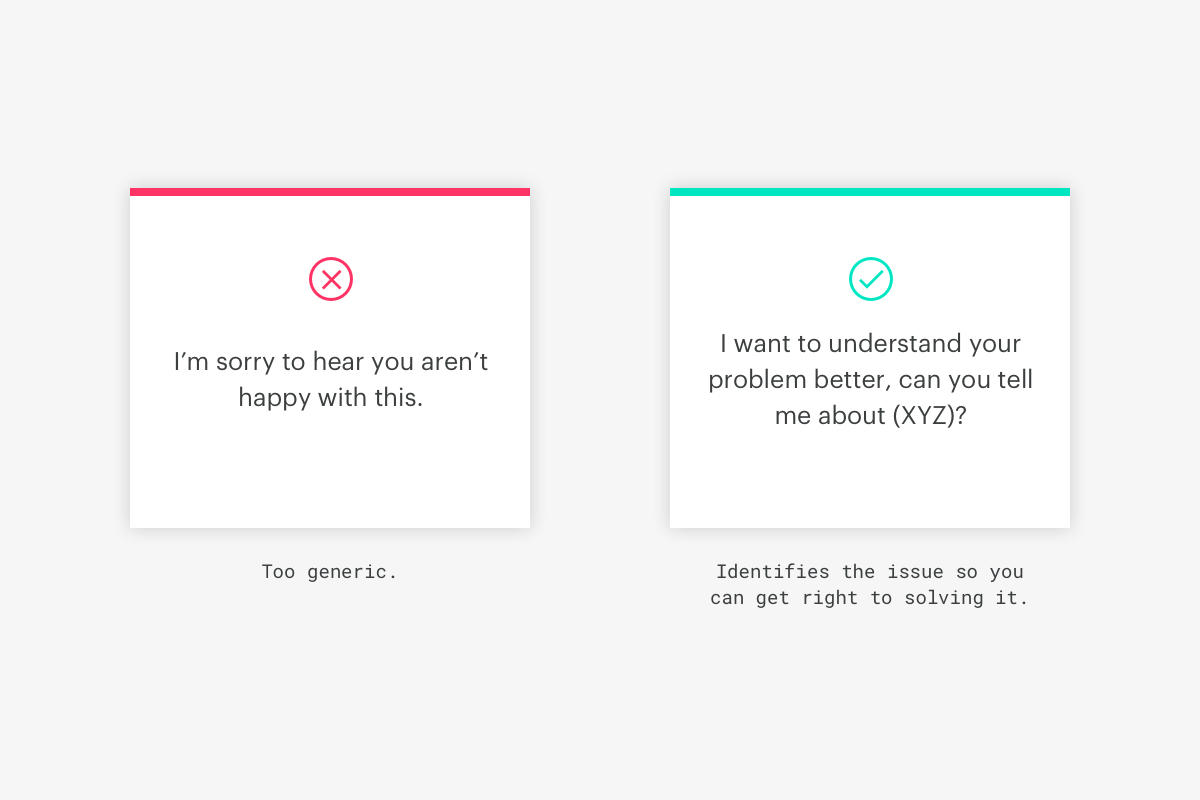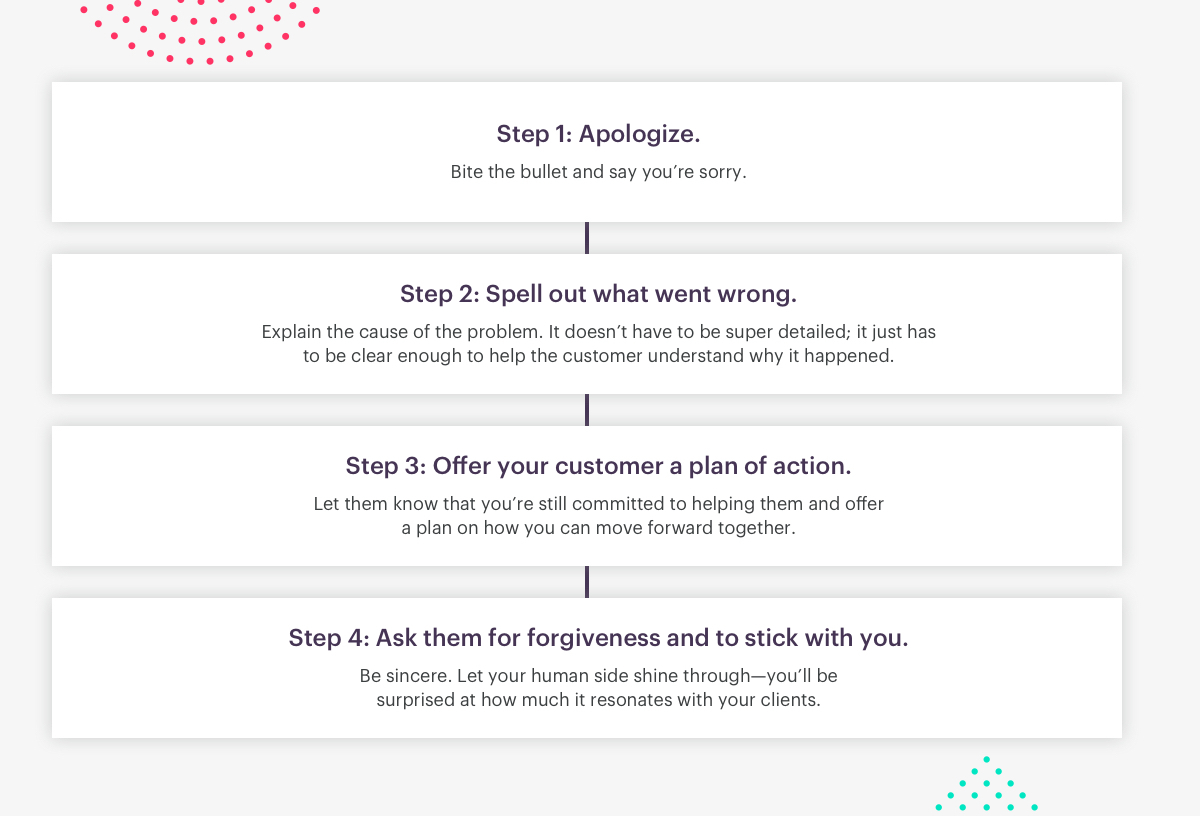
Kimberlee Meier
Contributor
Have you ever had the urge to apologize in a sales email?
Maybe your product isn’t performing how the customer had expected. Or your customer service team isn’t up to scratch and you’ve been put into the firing line.
Whatever it is that’s making you want to apologize—stop and think before you press send. Apologizing to a prospect has the potential to change the dynamic in your relationship, forever.
Before you hit send, take a look at these four reasons why you should avoid saying sorry in a sales email when it’s not necessary—and what you can do instead.
1. It can take away your credibility.
When you go into a sales pitch, you and your prospect both want something.
You both start on an even playing field—you can have a healthy negotiation to get the best result for both of you. But, if you start saying sorry in your sales emails, that playing field becomes uneven. Quickly.
It could have a long-term impact on the dynamic between you and your lead: instead of being someone who can offer a solution to a problem, you’re no longer viewed as an expert.
In fact, it casts doubt on your abilities to help them at all.
To be able to close that first sale and upsell in the future, you need to keep the balance between you and your lead. If you assume you’re intruding on their inbox, you might unconsciously guide your leads to assume the same.
This is not the impression you want to be communicating to potential clients.
Maintain your authority and show a strong stance. This shows your lead that you mean business and that you can be a serious player in their path to success.
2. You sound desperate.
Ah, the old guilt-tripping type of “sorry.” Unfortunately, the jig for this sales technique is up—guilting someone with countless emails just won’t work in the sales world anymore.
In fact, saying sorry can end any chance of a sale because you’re reminding your lead that you’re getting desperate.
For example, let’s say a lead hasn’t replied to your first sales email. Pretty standard—only 23.9% of sales emails are opened anyway.
So, the last thing you should do is panic and send something like this:
I didn’t get through the first paragraph, and I doubt anyone else did either. The email doesn’t offer any upfront value or personalization.
But one thing it does bring is the smell of desperation. Remember, you can’t guilt someone into replying to you who has no obligation to get back to you in the first place.
The email also apologizes for trying to get in touch with the lead. Why? Following up with a lead is one of the main parts of a sales rep’s job, so the need to apologize is redundant.
Instead of apologizing or guilt-tripping a lead, offer them upfront value instead. Take charge of the sale instead of taking the backseat. It’ll pave the way for the rest of the sales process.
Pro-tip: See the ultimate guide on how to craft the perfect sales email.
3. Sorry = admitting mistake = compensation
One thing that saying sorry can do is open up the door to discounts and compensation.
The reason? The moment you say sorry, you’re admitting to a mistake—whether you’ve made one or not.
Prospects will pick up on this kind of language straight away. After all, most people will jump at any opportunity for a discount or a better deal. That’s just human nature.
Sure, prospects might have an issue with the product you’re selling or how it’s functioning. But instead of apologizing, you should respond with something more like:
“I’m disappointed to hear you’ve been unhappy with [issue]”
From there, you can let the client know that you’re concerned and offer solutions to fix the problem ASAP.
You can still connect emotionally with the client and be empathetic to their situation without apologizing and admitting fault.
This way, you can resolve the issue together without resorting immediately to discounts or compensation. The company will escape unscathed and there won’t be any impact on your bottom line.
4. It starts to lose its meaning.
The more you apologize, the less it will mean. If it becomes a habit, your prospect or client will tire of it—quickly.
Why are you saying sorry? Is it because a customer is complaining about your product or service? If so, refer to point 3.
By saying sorry constantly, you take away your ability to be able to extinguish a future fire if your company does make a mistake.
So if you’re finding yourself doing this in follow-up emails:
“Sorry to bother you, but….”
Stop.
If you haven’t annoyed your prospect yet, this is a sure way to do it.
Not only that, but if you’re implying that you’re bothering your lead, there’s a good chance they’ll believe you.
Try reframing your emails to get your customers excited, rather than starting them off with a negative word like “sorry.” If you think you’re being polite and taking into account your client’s busy schedule, think again:
“Sorry to bother you, but I wanted to reach out to remind you of what I can offer you at {XYZ}”
VS.
“I know your inbox is sacred, but I wanted to show you what {your company} can offer {client’s company} to {help solve pain point}.”
Which one do you think your clients are going to respond to better?
What you should write instead?
To avoid feeling guilty for emailing someone, the best thing to do is qualify your lead first. That way, you can have some confidence that the lead is interested in your product in the first place.
Once they’re qualified, you can write a good follow-up email.
Pro-tip: learn about how to qualify your leads here.
Once you remove the word “sorry” from your vocabulary, doors will open. You’ll be able to respond to disgruntled customers without losing credibility, and you’ll see an increase in your conversions because you’ve managed to take charge.
If they’re annoyed—work with them to solve the problem.
Acknowledge their problem straight away and let them know you’re disappointed that they’re unhappy.
No matter how annoyed the customer is, there’s a good chance they want to sort it out as quickly as you do so they can get on with their day.
The best way to do this is to figure out the exact issue the customer has.

If you can’t solve the problem yourself, reach out to a department who can. Don’t shuffle your client around either—this will only add fuel to the fire.
Make sure you CC yourself on the email when you forward it to a different department. This shows your client that you’re staying with them until the issue gets resolved.
Above all, be genuine and don’t send a canned response. It’s easy to tell when a reply has been copied and pasted—and your potential customer won’t appreciate it.
If your company has messed up, say sorry and be sincere.
Of course, only take the advice we’ve given above if your company hasn’t messed up. If it has, the best thing you can do is be sincere, own up to your mistake, and apologize.
Do you remember when Netflix decided to jack up their prices for live-streaming without telling their customers? Yeah... that happened—and the fallout was huge.
But it wasn’t because the customers weren’t happy to pay for the service. It was because the customers didn’t get a real apology from Netflix for their mistake.
The company’s CEO, Reed Hastings, issued an email to explain the company’s decision along with a video to back it up:
But while they explained the reason behind the change in their service and what the benefits would be for its customers—they never really admitted fault.
Netflix’s stock dropped in value by 15% and nearly a million customers canceled their subscriptions.
So, how do you apologize... while still saving your credibility and keeping your customers?

Be sincere. Let your human side shine through—you’ll be surprised at how much it resonates with your clients.
How to nail your replies—every time.
If you’re worried that your sales team will fall into the trap of saying sorry to their clients, don’t be.
A CRM can help you build a template database for your sales reps so that they can completely avoid sending “sorry” emails.
These can range from simple follow-up emails to full-on fire extinguishers for when customers are irate.
Having a library like this for your sales team can help them make sure they maintain their credibility with clients. (It’ll help protect the company’s image, too.)
For example, a CRM lets you save multiple templates for whatever scenario your sales team may come across.
This will help your team stay consistent with their leads when replying in difficult situations—and save them hours as well.
Pick your battles
Saying sorry in an email can be a knee-jerk reaction, so picking the right time to back your brand is crucial.
If you have the tools to make this an automatic and professional response, it can help you maintain your credibility—and your bottom line.
And remember, if your brand does make a mistake, honesty is always the best policy.






